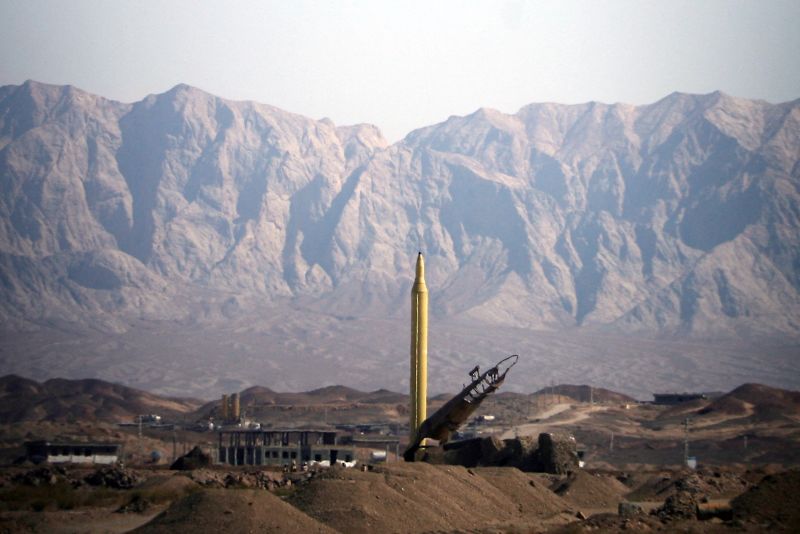
What are the missiles in Iran’s arsenal and how does Israel counter them?
Iran has unleashed its largest ever attack on Israel, firing 180 ballistic missiles late Tuesday most of which were apparently intercepted by anti-missile defenses employed by Israel, the United States and Jordan, according to those countries’ governments.
The aerial assault, far more serious than a similar strike in April, has raised the stakes in what is already an extremely tense moment across the Middle East as a dangerous regional conflict spirals.
Here’s a look at Iran’s ballistic missile capabilities and the defensive systems employed by Israeli and other forces in the region.
Iran’s missiles
Tehran has thousands of ballistic and cruise missiles with a variety of ranges, according to a 2021 report from the Missile Threat Project at the Center for Strategic and International Studies (CSIS).
Exact numbers for each type of missile are unknown. But US Air Force Gen. Kenneth McKenzie told Congress in 2023 that Iran had “over 3,000” ballistic missiles, according to a report this year from the Iran Watch website at the Wisconsin Project on Nuclear Arms Control.
Ballistic missiles’ trajectories carry them outside or near the limits of Earth’s atmosphere, before the warhead payload separates from the rocket that carried it aloft and plunges back into the atmosphere and onto its target.
The Shahab-3 is the foundation for all Iran’s medium-range ballistic missiles using a liquid propellant, according to Patrick Senft, a research coordinator at Armament Research Services (ARES).
The Missile Threat Project says the Shahab-3 entered service in 2003, can carry a warhead of 760 to 1,200 kilograms (1,675 to 2,645 pounds) and can be fired from mobile launchers as well as silos.
Iran Watch says the newest variants of the Shahab-3, the Ghadr and Emad missiles, have accuracies of as close to 300 meters (almost 1,000 feet) of their intended targets.
Iranian media reported that Tehran used a new missile, the Fattah-1, in the attacks. Tehran describes the Fattah-1 as a “hypersonic” missile – meaning it travels at Mach 5, or five times the speed of sound (about 3,800 miles per hour, 6,100 kilometers per hour).
But analysts point out that almost all ballistic missiles reach hypersonic speed during their flights, especially as they dive towards their targets.
The term “hypersonic” is often used to refer to what are called hypersonic glide vehicles and hypersonic cruise missiles, highly advanced weapons that can maneuver at hypersonic speed inside Earth’s atmosphere. That makes such weapons extremely hard to shoot down.
Fattah-1 is neither of those, according to Fabian Hinz, a research fellow at the International Institute for Strategic Studies, who wrote on the subject last year.
Hinz says the Fattah-1 appears to have a warhead on a “maneuverable reentry vehicle,” which enables it to make adjustments to avoid missile defenses during a short portion of its dive to its target.
Still, this ability would be an improvement on Iran’s earlier missiles, Hinz says.
But analysts were skeptical that Iran would have used the new missile for the first time on Tuesday night.
“It’s one of their newest ballistic missiles, and they have a lot to lose from using it,” said Trevor Ball, a former senior explosive ordnance technician for the US Army.
“Israel would get an idea of its capabilities just from being used. There’s also the chance it could fail to function, giving Israel an even greater idea of its capabilities. They get free propaganda and risk nothing by saying it was used.”
Israel’s missile defenses
Israel operates a range of systems to block attacks from everything from ballistic missiles with trajectories that take them out of the atmosphere to low-flying cruise missiles and rockets.
Much attention has been given to its highly effective Iron Dome system, which is used to combat incoming rockets and artillery weapons.
But the Iron Dome is the bottom layer of Israel’s missile defense and is not the system that would have been used to combat the ballistic missiles launched on Tuesday night, according to the country’s Missile Defense Organization (IMDO).
The next rung up the missile defense ladder is David’s Sling, which protects against short- and medium-range threats, according to the IMDO.
David’s Sling, a joint project of Israel’s RAFAEL Advanced Defense System and US defense giant Raytheon, uses Stunner and SkyCeptor kinetic hit-to-kill interceptors to take out targets as far as 186 miles away, according to the Missile Threat Project at the CSIS.
Above David’s Sling are Israel’s Arrow 2 and Arrow 3 systems, jointly developed with the United States.
The Arrow 2 uses fragmentation warheads to destroy incoming ballistic missiles in their terminal phase – as they dive toward their targets – in the upper atmosphere, according to the CSIS.
The Arrow 2 has a range of 56 miles and a maximum altitude of 32 miles, according to the Missile Defense Advocacy Alliance, which called the Arrow 2 an upgrade on the US Patriot missile defenses Israel once used in this role.
Meanwhile, the Arrow 3 uses hit-to-kill technology to intercept incoming ballistic missiles in space, before they reenter the atmosphere on their way to targets.
During Tuesday night’s attack, the US military said it fired at least 12 anti-missile munitions against the incoming Iranian missiles.
The US response came from the Navy guided-missile destroyers USS Cole and USS Bulkeley which were operating in the eastern Mediterranean Sea, Pentagon spokesperson Maj. Gen. Pat Ryder said.
The Pentagon did not specify the interceptors used, but the US destroyers are equipped with the Aegis ballistic missile defense system, with interceptor missiles that can strike and destroy incoming ballistic missiles in their mid-course or terminal phases.
Jordan’s air force also intercepted Iranian missiles on Tuesday night, a Jordanian official said, but no specifics were given.
During an Iranian attack on Israel in April, Israeli and US warplanes shot down a large number of the incoming Iranian munitions. But Iran carried out that attack largely with slower-moving drones, which were much easier intercepts for the fighter jets than the ballistic warheads falling vertically on targets in Israel.
